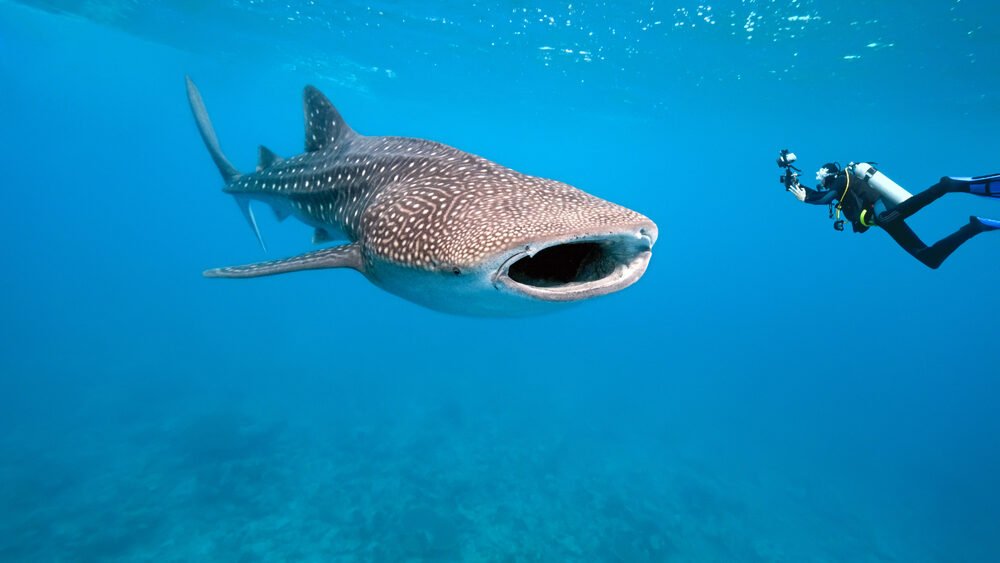Whale Shark Facts, Habitat, Captivity, Comparisons & FAQ
Quick, interesting facts about the whale shark
- Scientific name: Rhincodon typus
- It’s the world’s biggest omnivore.
- Estimated max weight: 37-43 tonnes
- Max length: 18.8 meters or 61.7 feet.
- Estimated lifespan: 80 to 130 years.
- Habitat: Tropical oceans above 21 degrees Celcius or 70 degrees Fahrenheit.
- They are filter feeders, passing water through filter pads to feed on plankton and small fish.
What is a whale shark?
A whale shark is a type of shark and is the largest fish in the world. They can grow to over 60 feet (18 meters) and weigh over 21 tons, and their diet consists primarily of plankton and small fish.
Whale sharks live in tropical and warm oceans all over the world. They are generally shy and passive creatures and harmless to humans.
We need to learn more about these fantastic creatures. Still, we know that habitat loss endangers them—overfishing and being caught as bycatch in fishing nets. Some humans have captured whale sharks and put them in aquarium captivity.
Suppose you would like to encounter a whale shark. In that case, there are hot spots where the concentration is significant and provides a good chance of seeing them in the wild. We recommend this over visiting an aquarium, as many whale sharks have failed to acclimate to life in captivity and died.
Scientific classification of whale shark
- Species: Rhincodon Typus
- Family: Rhincodontidae
- Order: Orectolobiformes
- Superorder: Seachimorpha
- Class: Chondrichthyes
- Phylum: Chordata
- Kingdom: Animalia
Habitat

A whale shark’s habitat is in tropical oceans with warmer water temperatures than 21 degrees Celcius, usually between 30 degrees north and 35 degrees south. They inhabit shallow and deep water, corals, reefs, and lagoons.
It has been found in the Pacific Ocean, as far north as the coast of California and south to Zona Sur in Chile. On the other side of the Pacific, it lives between Australia’s east coast throughout Northern Oceania islands and up past Taiwan.
The shark lives all over the Indian Ocean, from Australia’s west coast to the Persian Gulf and the Red Sea, and as far south as Cape Agulhas of South Africa.
In the Atlantic Ocean, you can find this giant fish along the African coast from the shores of Angola to Mauritania, all the way to Brazil, the Caribbean, and as far north as Delaware in the USA.
An endangered species
The whale shark is considered an endangered species by the IUCN, a list compromising 3079 animals and growing. The IUCN red list category consists of extinct, extinct in the wild, critically endangered, endangered, vulnerable, near threatened, conservation dependent, and least concern.
Even though they pose no threat to humans, they are sometimes the target of fisheries as a food source since people eat the meat and use their fins in soups in some parts of the world. Sometimes they are accidentally caught in fishing nets or fish traps but are way too heavy for the fishermen to bring up.
Whale sharks may be vulnerable to extinction, but whale watching has become a popular tourist activity. Since sharks are scarce, the comparative value of keeping them alive rather than fishing them has increased.
The remaining population of whale sharks is estimated to be somewhere between 120,000 and 240,000 in the wild. Conservation efforts may help protect them, but it is difficult due to the many threats.
Whale sharks in captivity and aquariums

Whale sharks in captivity face numerous challenges that make it difficult to acclimate and survive.
The stress of captivity can take a toll on their health, and the lack of space and natural surroundings can make it hard for them to adjust. As a result, the survival rate for captive whale sharks is low.
Since the sharks can grow up to 18 meters, they require gigantic tanks to live in – and it has become a status symbol for some aquariums to have them.
Okinawa Churaumi Aquarium was the first to have whale sharks in captivity in 1980. They have the longest record for a whale shark in captivity for 27 years.
Since the 1990s, aquariums in several countries, such as Japan, South Korea, China, Taiwan, India, and Dubai, have kept them. Outside of Asia, there is only Georgia Aquarium in Atlanta, USA, which started importing whale sharks from Taiwan in 2007 and is currently holding a few.
Comparisons
Whale shark vs. blue whale
The average blue whale grows to lengths of 80 feet, whereas the average whale shark is only 40 feet.
Whale sharks live in tropical and subtropical waters worldwide, and blue whales live in colder waters, such as the Arctic and Antarctic waters.
Blue whales eat krill and small fish, whereas whale sharks eat plankton and small fish.
Whale sharks compared to a human.

The most significant difference between whale sharks and humans is that they live in the sea, and we live on land.
Also, they have the weight and mass of a school bus, and we are 50-100 kg creatures.
Whale shark vs. Megalodon
While the whale shark is the largest fish in the world today, an extinct species known as Megalodon was once the largest predator on Earth. The Megalodon went extinct around 3.6 million years ago.
Some scientists believe the Otodus Megalodon could reach up to 24.2 meters, with a mean length of 20.3 meters, and could weigh from 59 to 103 metric tons.
Scientists estimate that the Megalodon would need to consume 98,000 kcal daily to maintain its mass – that’s 49 times more energy than a human being.
These creatures have some key differences. The whale shark is a filter feeder, eating plankton and tiny fish. The Megalodon was a massive predator, almost like a T-Rex of the sea, hunting large sea mammals, whales, large fish, and sharks.
The most crucial difference is that the Megalodon went extinct millions of years ago, and the whale shark is still around today.
Whale shark vs. Basking shark
The whale shark is the largest fish in the world, and the basking shark is the second largest. Both are filter feeders.
The main difference between these two giants is that they inhabit regions of the oceans.
The whale shark prefers warm tropical waters, whereas the basking shark thrives in colder water, much further north and south.
The basking shark can also live on the coast of Europe and the Mediterranean sea, which the whale sharks avoid.
Whale shark vs. Great white shark
The most significant difference between these two sharks is how they feed.
We consider the whale shark a harmless filter feeder, eating small fish and plankton.
The great white shark is an aggressive predator hunting large prey and is feared by humans worldwide.
Whale watching in Oslob, Cebu, Philippines

Humans have started considering swimming and diving with whale sharks to be a rewarding experience since they are harmless.
Some places have become tourist hotspots because of the high concentration of whale sharks.
One of the places is Oslob in Cebu in the Philippines, which may be the most popular whale shark watching place in the world. It attracts numerous tourists yearly who want to dive and swim with the gentle giants.
Frequently Asked Questions
What does a whale shark eat?
They are filter feeders, so their diet consists of plankton and small fish. They swim around with their mouths open, and water and potential food pass through their filter pads and gills.
Is a whale shark a whale, a mammal, a shark, or a fish?
The whale shark is a shark and a fish since sharks are fish. It is not a whale and, therefore, not a mammal. Their feeding behavior is more characteristic of whales than sharks, which is how it got its name.
Does whale shark have teeth?
They have many tiny teeth in their jaw. Compared to the size of the fish, the teeth are considered minuscule.
Can a whale shark swallow a human?
Hypothetically, a whale shark can swallow a human, but it has never happened as far as we know.
In the hypothetical scenario of swallowing a human, it’s not like the whale shark would gulp the human down the throat, never to be seen again.
The human would likely get stuck in its mouth’s opening or interior, as the fish filtrates water and anything larger than 2 cm through its gills.
Some scientists believe that the whale would cough out anything of significant size that may get stuck in the gills. Still, scientists have yet to confirm this behavior.
If you are scared of this fish, realize that they swim slowly and won’t actively try to feed on anything close to the size of a human since it can’t consume them.
If you encounter a whale shark, leave them alone, give them space, and observe from a distance.

